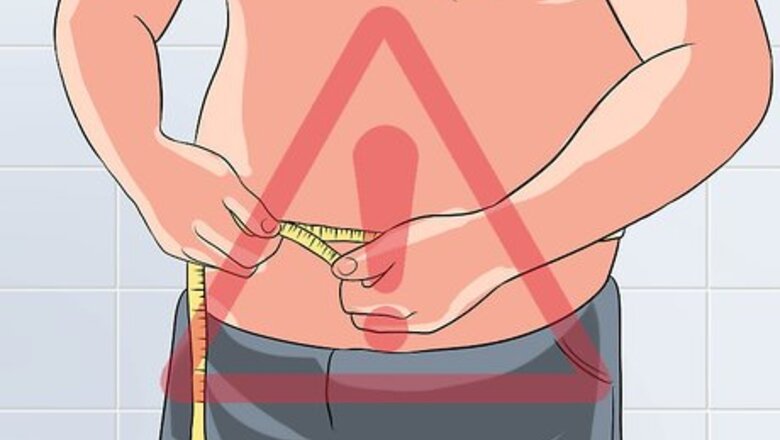
views
X
Trustworthy Source
Centers for Disease Control and Prevention
Main public health institute for the US, run by the Dept. of Health and Human Services
Go to source
Research suggests that cisgender men are more likely to ignore breast lumps than cisgender women, but early diagnosis is key to getting the treatment you need to recover.[2]
X
Trustworthy Source
Johns Hopkins Medicine
Official resource database of the world-leading Johns Hopkins Hospital
Go to source
Try not to worry, but talk to your doctor immediately if you have any concerns about your breast health.
Identifying Symptoms of Male Breast Cancer

Recognize your risk for male breast cancer. Doctors do not know what causes male breast cancer, but are aware that certain factors can increase your risk of developing the disease. Being aware of your potential risk can prompt you to check yourself and see your doctor regularly. The following factors can increase your risk of male breast cancer: Age — most people who have breast cancer develop it after age 60 Exposure to estrogen — either through medication as a part of a gender reassignment procedure or hormone therapy for prostate cancer Family history — if you have one or more close family members who developed breast cancer, you are more likely to get the disease Klinefelter’s syndrome, which causes your body to produce less male hormones and more female hormones Liver disease, such as cirrhosis, which increases female hormones in your system Obesity Alcoholism Exposure to radiation on your chest area Certain testicle diseases or types of surgery on your testicles Gynecomastia, or abnormal enlargement of both male breasts BRCA2 gene mutation

Determine potential signs of male breast cancer. Cisgender men have small amounts of breast tissue and any changes should be evaluated. Many people don’t think about the health of their breasts, but there are several signs and symptoms of male breast cancer to watch for. You may notice these during routine activities such as showering or changing your clothes. The following may be signs of male breast cancer: Thickening of your breast tissue Developing a painless lump in your breast Changing texture of the skin on your breast including dimpling, puckering, redness or scaling Inverting of your nipple Having clear or bloody discharge from your nipple Experiencing pain in your breast Developing sores on your nipple or areola Having enlarged lymph nodes under your arm
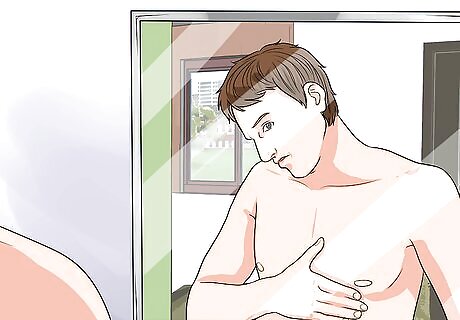
Examine your chest for irregularities. You may notice some irregularities develop on your chest or breast(s) as a result of male breast cancer. Keeping an eye on your breasts and skin can alert you to perform a breast self exam and see your doctor. Check your chest and breast skin regularly so that you can more easily detect changes to them. Stand in front of a mirror and look at your chest area once a week or month, especially if you know you are at risk for the disease. Compare each breast and notice any differences in the texture or shape. If you do notice any changes, perform a breast self-exam to see if you can detect any further symptoms through touch. See your doctor if you notice any possible symptoms of male breast cancer. The sooner you detect and get treatment for possible male breast cancer, the better your chances of curing the disease.
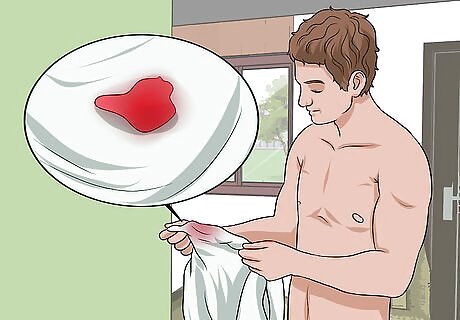
Notice pain or discharge. In addition to examining your chest skin, pay attention to any pain you feel in your breasts. You should also watch for any clear or bloody discharge coming from your breasts. Both of these symptoms can indicate male breast cancer, especially if you have them over a longer period of time. Check for any moist spots on your shirts, which can be a sign of discharge. In addition, simply examining your breasts on a regular basis may help you detect discharge. Notice if you have any pain when wearing clothing, touching your skin, or during activities such as exercise.

Discuss concerns with your significant other. If you suspect any changes to your breasts, make sure to talk to your significant about your concerns. Your significant other may recognize symptoms or differences in your breasts that you did not see. They can help you perform a breast self-exam to detect further changes and provide much needed support while you get medical attention. Be open and honest with your partner about your concerns and what symptoms you’ve detected. Ask your partner about any changes they have noticed. For example, you could say, “I’ve found this scaly patch of skin on my nipple and sometimes there’s a clear liquid that comes out of it. Have you noticed this as well? Would you mind helping me take a closer look at it?”

Be aware of gynecomastia. If both of your breasts become larger, this condition is known as gynecomastia. Generally, this is not breast cancer, even though your breasts can become quite large. Gynecomastia is sometimes caused by medications, heavy alcohol consumption, marijuana use, or weight gain, though the cause is often unknown in many cases. Although having gynecomastia doesn't mean you have breast cancer, there is some evidence that suggests the condition may increase your risk of developing male breast cancer. If you are concerned about gynecomastia, schedule an appointment with your doctor.
Performing a Breast Self Exam
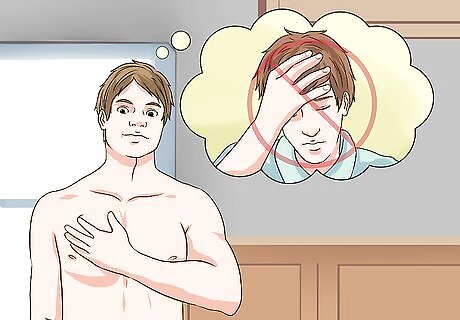
Be confident. Even though it’s rare in males, it’s important to check for breast cancer if you are at high risk or have symptoms. Don’t allow yourself to feel embarrassed or emasculated by taking care of your health, including performing a breast self-exam on yourself. Breast cancer affects all genders and neither developing the disease nor giving yourself an exam bear any reflection of your masculinity.
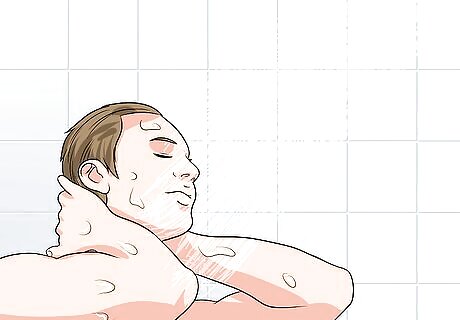
Take a warm shower or bath. The most optimal time to perform a breast self-exam is after a warm shower or bath. The warmth smooths out your skin and makes it easier to perform the exam. Consider doing a preliminary check of your breast tissue while you’re in the shower. You can examine and feel your breasts while you’re showering or bathing.
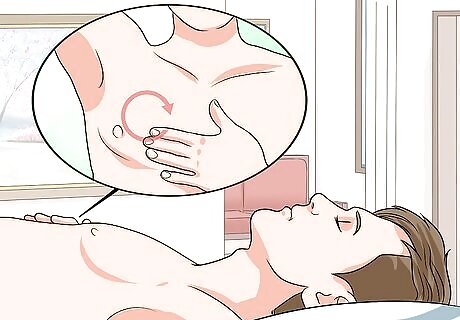
Press your breast tissue. A breast self-exam requires feeling your breast tissues in a thorough and methodical manner. Check each breast individually by using the opposite hand to the breast you want to examine. Work from the outside of your breast by your armpit and feel around the entire breast to ensure you’ve checked every surface of the tissue. Lie down flat on your bed, the floor, or a table so that your breast tissue is evenly spread out across your chest. Lay your fingers flat on the breast you’re examining. Then firmly press the tissue in small, clockwise circles. Start at the outermost top edge of your breast and spiral the circles in towards your nipple. Use this technique for your entire breast and then repeat the process on the other side. Make sure you are checking your armpits as well. Feel for lumps and bumps during the exam and note where you find them. This can help your doctor more quickly locate them during any subsequent exams. In addition, make sure to closely look at your breast skin during the examination, which can help you identify any other changes such as puckering, dimpling, or scaly skin.

Check your nipples. Once you’ve thoroughly felt each of your breasts for changes, you should also check your nipples. Look at the skin, feel it with your fingers, and gently squeeze them to see if there is any discharge.
Getting a Diagnosis and Treatment
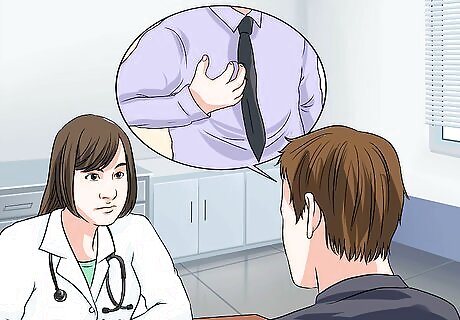
See your doctor. If you find any signs or symptoms of male breast cancer and / or are at risk for it, visit your doctor as soon as you are able. Early detection and diagnosis can significantly increase your chances of successful treatment and survival. Make sure your doctor’s office knows why you are scheduling the exam so that your doctor can provide prompt attention to your symptoms or concerns. Tell your doctor about any symptoms of male breast cancer that you have including changes to your breast appearance and the way it feels. Alert the doctor to any lumps or irregularities you felt during a breast self-exam. Since there are other reasons for breast changes in men, giving a thorough and honest history is important and should include any medications, herbs, or supplements that you are taking or receiving from other professionals. Not providing proper information could hinder your doctor’s ability to diagnose cancer or another condition.
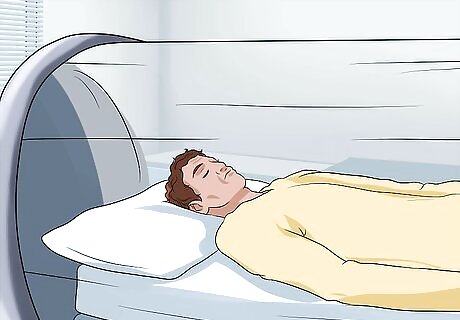
Undergo testing. If your doctor suspects breast cancer, they will likely perform a clinical breast exam and order further testing. Tests including biopsies and imaging tests can better help your doctor diagnose breast cancer, determine the extent of the disease, and develop the best treatment plan for you. Allow your doctor to examine your breasts and perform a clinical breast exam. Like a self-exam, a clinical breast exam will include your doctor using their fingertips to feel for lumps or other changes in your breasts and surrounding tissues. The exam can also tell your doctor things such as the size of any lumps, the way they feel, and their proximity to your skin and muscles. Make sure to let the doctor know if you experience any pain during the exam. Get imaging tests including mammograms, ultrasounds, CT scans, and MRIs if your doctor prescribes them. These tests can help your doctor more closely look at tissue irregularities and determine the extent of any cancer you may have. Have a biopsy to remove lumps or suspect breast tissue. Biopsies, where a fine needle is inserted into the tissue to remove tissue for laboratory analysis, can also help determine if you have breast cancer and, if so, what type of cancer it is.
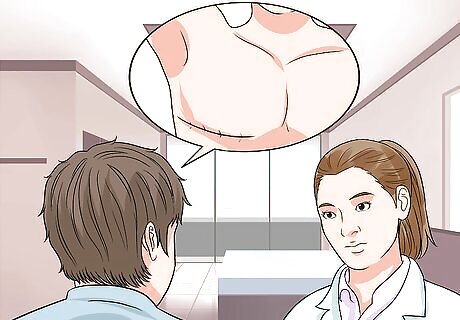
Receive treatment. If testing discovers that you have cancer, your doctor will develop a treatment based on the severity of your condition. There are different treatment options for male breast cancer, all of which can successfully treat and cure the disease. Remember that early detection and diagnosis are key to treatment. Talk to your doctor about your treatment options and any concerns you may have. Ask questions about the diagnosis and nature of your breast cancer as well as the best ways to treat your specific case. Consider surgery such as a mastectomy to remove any tumors and surrounding tissue. In addition, you may require surgical removal of one lymph node to help determine if your breast cancer has spread. Undergo radiation therapy, which uses high-energy beams from sources like X-rays to eliminate breast cancer cells In many cases, radiation is combined with mastectomy to most effectively kill and remove breast cancer cells. Receive chemotherapy drugs by pill or intravenously to kill cancer cells. Chemotherapy can be used in conjunction with surgery and may be a good option for men with advanced cases of breast cancer. Consider hormone therapy if your breast cancer is hormone-sensitive. This usually includes taking the medication tamoxifen, which many people with female breast cancer also take. Be aware, though, that other hormone therapies used on female breast cancer patients do not work for males. Try targeted drug therapy, which attacks defects in cancer cells. Drugs such as Herceptin and Avastin may slow or even stop the growth of cancer cells; however, they can come with the side effect of heart damage. Ask your doctor about participating in a clinical trial for male breast cancer. This option may provide you with a new and different treatment method that can kill your breast cancer.

Cope with breast cancer. If you receive a diagnosis of male breast cancer, it may shock and upset you. Using different methods to cope with the disease can help you better deal with any stress or challenges that may arise because of the disease. You might want to try: Talking with a trusted person or medical professional about your diagnosis Praying or meditating to help calm yourself Exercising, which can help you feel better physically and mentally Undertaking creative activities such as music, art, and dance, all of which can help you de-stress and feel better Joining a local or national male breast cancer support group


















Comments
0 comment